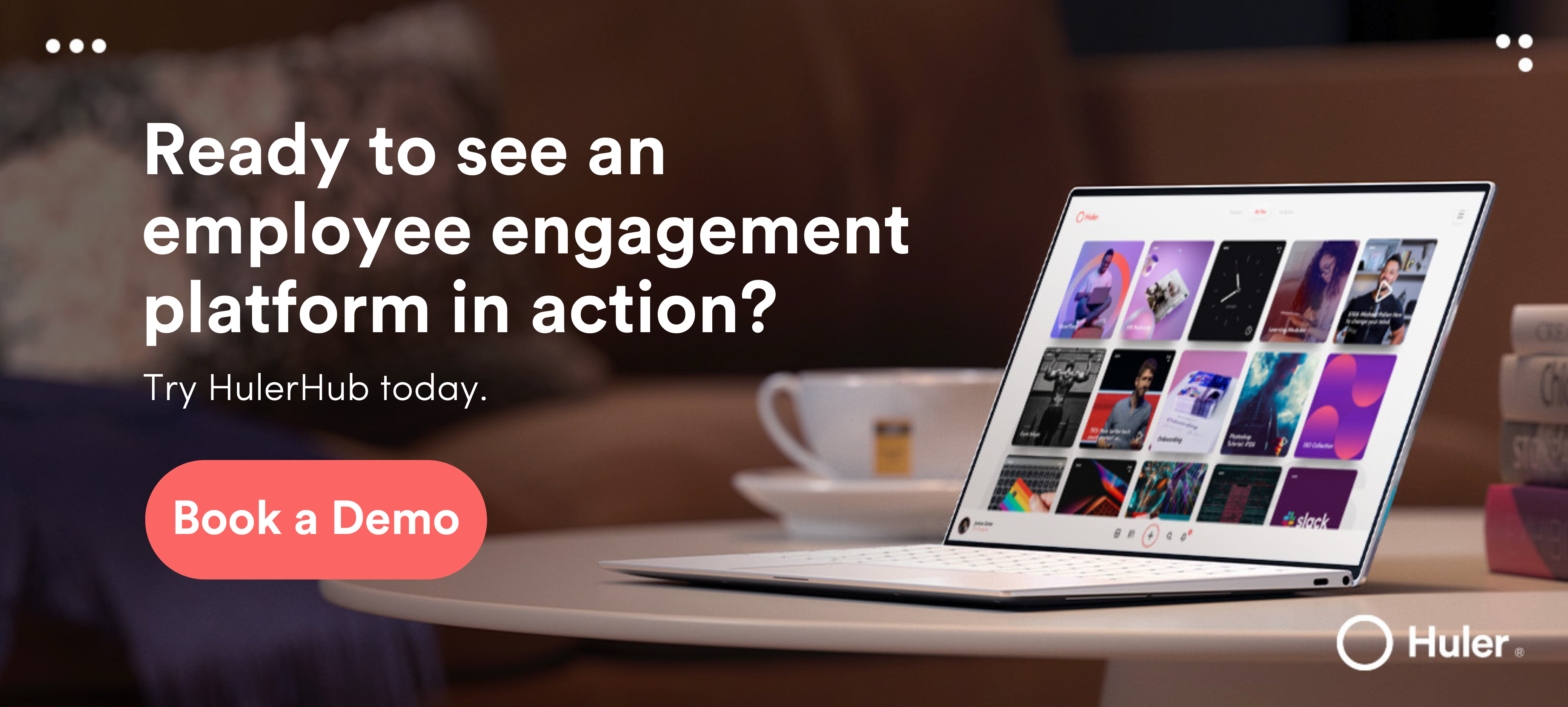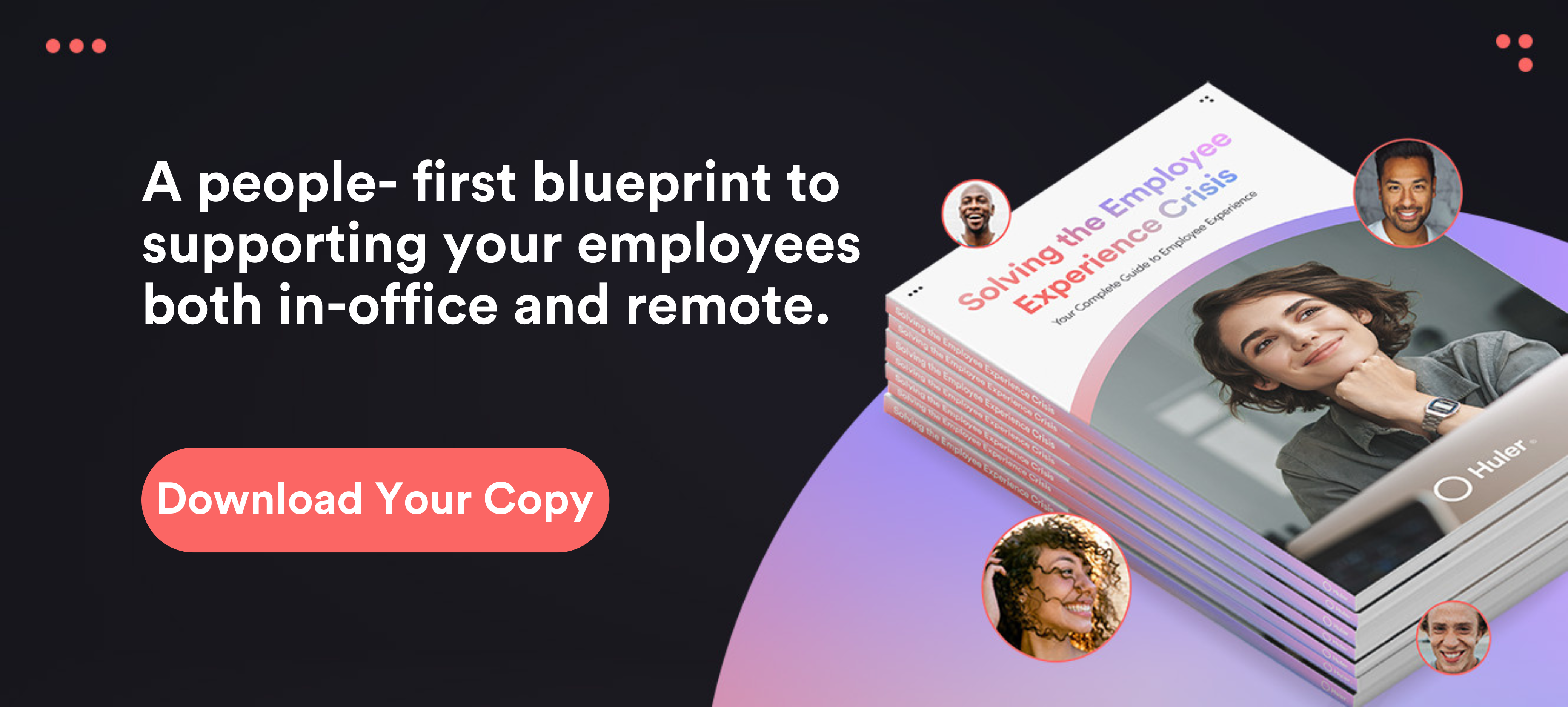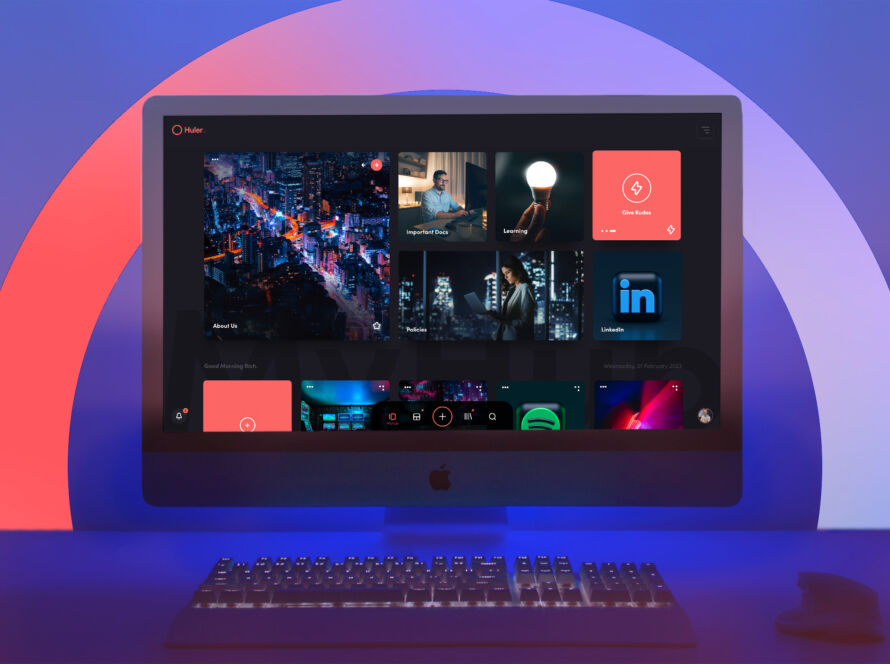Employee engagement is a top priority for businesses right now. As HR managers and leaders realise the value of an engaged workforce, more is being done behind the scenes to proactively meet employees where they are and deliver on their high expectations, needs and wants.
As with pretty much anything, technology can play a big part in your people engagement strategy, starting with employee engagement platforms.
Employee Engagement Platform Guide
- Introduction and Definition
- Employee Engagement Platform Features
- Why Do Businesses Need An Employee Engagement Platform?
- Employee Engagement Platforms and the Employee Experience
- Frequently Asked Questions
- Conclusion
Introduction
To say we all had a wake up call in 2020 was an understatement. Within just a few months of the new year COVID-19 showed us just how quickly our whole world can change overnight. Inevitably, this drastic event affected all areas of our lives, including where we worked, how we worked and how we felt about work.
While employee engagement was already on the radar of HR managers in particular, as a large majority of the workforce moved to remote working it became more urgent than ever to keep employees connected, productive, and motivated. According to recent surveys from Gallup, 20% of employees globally are currently engaged at work. That leaves a whopping 80% of employees the world over who are disengaged or even actively disengaged (meaning they are outwardly unhappy).
When you take the above into account, engaging your employees can’t be left to chance. Instead, it’s vital to be proactive about employee engagement, with a clear strategy and the right employee engagement tools in place to go the distance.
What Is An Employee Engagement Platform?
Employee engagement platforms help organisations encourage, track, measure and understand workforce engagement. These tools often come with a number of features designed to improve internal communications, measure employee sentiment, shape the employee experience, recognise achievements, and promote a good work-life balance.
As a good employee engagement strategy involves a personalised approach, the best employee engagement platforms offer flexibility across a number of different user experiences.
For employees, employee engagement tools support them to feel better connected to their organisation and aligned with core business goals. They also empower employees to work autonomously and flexibly, presenting opportunities for better collaboration and communication.
For HR departments, employee engagement software pulls together all the information they need to understand what’s happening across the organisation. Through these platforms they can draw actionable insights from real-time employee feedback, such as dips in employee sentiment related to a specific event or which internal communications resonate best with the workforce.
In short, employee engagement platforms can bring a number of different features and benefits to the table depending on your goals and future plans. Crucially, however, these platforms focus on helping organisations create a people-first culture that actively listens and responds to how employees feel.
Employee Engagement Platform Features
When used in tandem with a comprehensive strategy, there are many benefits to an employee engagement platform. Not only do they work to better engage your people, they also can be used to improve onboarding processes and induction experiences, boost productivity and ultimately improve retention.
Personalised Internal Comms Dashboard
Keeping your workforce firmly on the same page is notoriously difficult. Emails and instant messages can easily get missed or forgotten amidst the cut and thrust of the working day, which can quickly lead to miscommunications and misunderstandings.
Many employee engagement platforms offer internal comms features such as homepages or dashboards that give employees access to all of the relevant information they need in one place. This is particularly beneficial for keeping hybrid and remote teams in the loop. But that’s not all!
As we know, personalisation of the employee experience is key to engaging your workforce. To help with this, internal news dashboards can also be personalised, with admins able to show the most relevant content to the right people at the right time.
Intuitive User Experiences
We all use technology every single day. And our expectations of it are high. Work technology is infamously clunky, slow and frustratingly hard to navigate, but employee engagement software aims to overcome that. These tools are specifically designed to look and feel like the technology we use every day with engaging visuals, intuitive navigation, powerful search and flexibility to accommodate different ways of working.
Onboarding Tools
First impressions count for a lot, which is why a well-planned, thorough onboarding process is crucial in businesses of any size. Onboarding tools in employee engagement platforms can help HR departments streamline and centralise these processes so that they can focus on delivering more people-centric induction experiences.
Good onboarding tools should give new hires everything they need to hit the ground running in one simple, accessible place. This can include forms and paperwork, employee handbooks and policies, who’s who documents, role specific software, and reports.
Analytics
There’s no way of truly knowing how engaged your workforce is if you can’t measure engagement. Analytics are a staple of employee engagement tools. These features give HR departments and admins a thorough insight into how employees are engaging with software and content, their productivity levels throughout the day, sentiment, and working hours.
Having access to this data helps you to understand what type of content interests employees, which software they use most, which software they don’t use at all and how they are feeling in themselves and about their work. All of this combined can help to inform strategies such as preventing burnout or re-engaging actively disengaged workers.
Mobile Friendly
Work from anywhere and work from roam concepts are becoming more popular, but employees are quickly discovering that their current tech stack doesn’t really work when they’re untethered from the office. And that leads to (you guessed it) low engagement levels as employees aren’t able to work in a way that works for them.
Mobile friendly employee engagement platforms, with features such as Single Sign On (SSO) can make accessing the tools your people need much easier, enabling them to work not just from home but remotely from anywhere.
Notifications Centre
If 2020 taught us anything, it’s that timely and effective crisis comms are imperative in any organisation. It also taught us that employees actually want more communication and transparency from employers. Problem is, it’s not always easy to deliver communications across a distributed workforce.
Employee engagement platforms can help with this however. These tools can be used to send push notifications to employees, making them instantly aware of must-see updates to their dashboards and drawing quick attention to change communications as and when they occur.
With the help of analytics, admins are also able to see who has interacted with what communications and follow up with those who haven’t to ensure nothing important gets missed or forgotten about.
Knowledge Base
Even small companies have reams and reams of information to keep on top of. As growth occurs, managing all of it and developing processes to keep it logical and accessible can be even harder.
Employee engagement platforms can also act as a knowledge base, or single source of truth, for your workforce to make sure they have quick access to the most up to date information as and when they need it. Dynamic search features can also help to surface that information, especially in bigger organisations where there is a lot to work through. While audience management capabilities can ensure only those with express permission to see certain content have access to it.
Why Use An Employee Engagement Platform?
If it’s your job to make a business case for an employee engagement platform, you’ll want to answer the question of: why? Why should your business use one? What are the benefits of an employee engagement platform?
It’s important to understand at this point that no piece of software is a replacement for strategy. Technology is, at the end of the day, an enabler and it can help to streamline or make other processes easier. But employee engagement platforms are the most successful when they are implemented alongside a people-centric engagement strategy.
Better Support Your Teams
With some HR influencers predicting that the next pandemic will be a mental health one, the spotlight is firmly on employee wellbeing. Employee engagement software can be used to support your mental health at work strategy by helping to make wellbeing resources and information more accessible and visible to your workforce.
Alongside this, sentiment and happiness tracking can be a powerful tool for taking a proactive approach to burnout. In distributed workforces, it can be very challenging to keep a responsible, watchful eye on employee stress levels. Employee engagement tools can help you clearly see changes in employee sentiment or falling engagement and productivity levels, so you can take steps to put the brakes on sooner rather than later.
Improve Communication
Lack of feedback and internal comms, too many emails, a glut of devices, irrelevance and asynchronous working can leave employees disconnected and disengaged. Employee engagement platforms can work to overcome this by providing a one-stop shop for all important internal comms.
When logging on to their personalised digital workplace, employees are confident that the news they see is exactly what they need to see with no danger of them being left out of the loop. Furthermore, when they need to find information it’s much easier for them to do so as everything is stored in one place and can be found in a single search.
Save Time
Employee engagement tools have the potential to save time for HR teams and employees. In them, employees have everything they need within just a few clicks with powerful search features to help them surface specific information in a timely way. This means they spend less time looking for the information they need and more time doing.
Engagement software also helps to save HR time in a number of ways. Firstly, as employees have access to everything they need they are less likely to spend lots of time having to answer the same questions over and over again, freeing up vital time to spend on more meaningful, people-first tasks. Secondly, with the help of analytics, HR departments can quickly collect and digest data from employees and use it to make changes in a timely, proactive manner.
Facilitate Growth
Employee engagement platforms can help to facilitate organisational growth in a number of ways. In the first instance, the tools can be used to improve the onboarding experience, leading to better retention across the board. Of course, when you retain your best people and they feel good about their work, your company is more likely to grow and succeed.
Secondly, employee engagement software can boost employee productivity leading to increased business performance. When tasks are streamlined, employees remain more focused and information is readily available, everything works better from customer experience right down to innovation and creativity.
Finally, these tools also help HR departments to take a proactive stance on employee experience instead of leaving it as an afterthought. When teams are better informed and driven by a people-first approach, it is much easier to meet the needs of everyone and provide personalised experiences in a transparent environment. Winner!
Employee Engagement & Employee Experience
Employee engagement and employee experience aren’t the same thing, but they are linked to one another. Employees become more engaged when the employee experience lives up to their expectations, so it’s paramount for leaders and HR departments to focus on both as a priority.
When organisations better understand what their employees need from their work and their employer, they are better placed to provide that. This then starts a domino effect that leads to higher engagement levels, productivity and performance.
In theory this is easy, but it’s also more challenging than it looks. The pandemic saw employees become more vocal about what they will, and won’t, put up with at work, resulting in them leading widespread change with regards to flexible working in particular. This rapid change made employee engagement more important than ever.
Employee engagement tools can be a powerful asset in your armoury that will sense the rumblings of change and flag trends before they become fully established, giving you the power to meet employees where they are early and stay agile as they change.
Suggested reading: Want to explore what an employee experience platform is? Read our blog: ‘What is an Employee Experience platform?‘
Employee Engagement Platform FAQs
Is an employee engagement platform the same as an employee experience platform?
The short answer is: it depends on which platform you use. There are a huge amount of employee engagement and employee experience tools out there and while some do cross over, others don’t. Some employee engagement platforms, for example, are used purely as a feedback or survey too. They don’t offer any sort of front-end for employees to engage with in a way that’s useful to them, instead they are used to collect vital insights into engagement levels across certain areas.
On the other hand, some employee engagement platforms offer employee experience features too. For example, HulerHub is an employee experience platform that offers both employee facing features that streamline and personalise the employee experience as well as analytics and insights that can help HR teams shape and steer employee engagement strategies.
Are employee engagement platforms just for big businesses?
Not at all! Employee engagement platforms can be used by businesses of all sizes to measure productivity, engagement, sentiment and much more. As long as you have employees to engage, it’s definitely worth the investment. What’s more, with tools like HulerHub you only pay per user and there’s always scope to add more users, making them scalable without going over budget.
Do employee engagement tools work for distributed teams?
Absolutely. In fact, these digital tools are made for distributed teams. As many of these solutions are cloud-based, they can be used securely on any device, anywhere in the world, which makes them a fantastic choice for remote first, hybrid and frontline workers. If you’re working to keep your distributed teams happy, an employee engagement platform is a staple in your armoury!
What metrics do employee engagement platforms use?
Measuring employee engagement in meaningful ways can be tricky. Employee engagement platforms aim to make relevant data easier to collect and simpler to interpret.
Employee engagement tools can vary in the metrics they track and what they call them including eNPS, turnover rate, quality of hire, sentiment, productivity, confidence, alignment, empowerment, innovation and much more. What matters when it comes to choosing the right employee engagement platform for you is does it track what it needs to and does it offer the functionality you need it to?
The Road To People-First Employee Engagement
Employee engagement has never been more important than it is right now as we emerge from the panic stations of the pandemic. While an employee engagement platform won’t change culture or job satisfaction by itself, it can be a valuable tool in better understand what employees need and how as an employer you can deliver on that in ways that are aligned with business goals.
To help your organisation boost employee engagement, we developed HulerHub. An employee engagement platform for businesses of all sizes, our flexible and intuitive platform acts as the front door to your organisation. For employees, it puts everything in one place including internal comms, tools and data. For HR departments and leaders, it gives a no holds barred insight to how workers are feeling, engaging and working across the company. To see HulerHub in action for yourself, book a demo today!








